
What women of Sea Grant want: science is in, spin is out
September 11, 2023
By Lynn Fantom
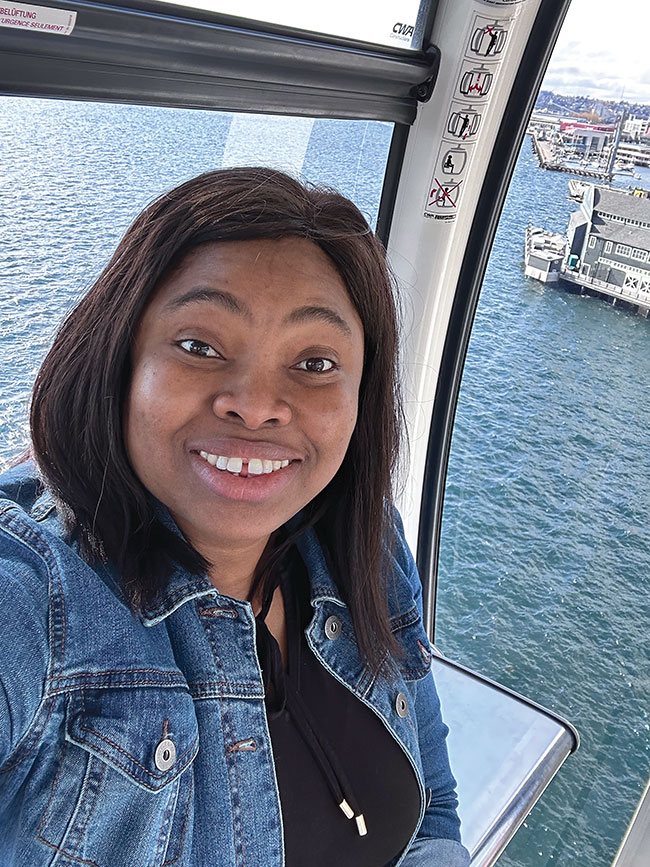 Lilian Elekwachi, John A. Knauss Marine Policy Fellow Photo courtesy of Lilian Elekwachi
Lilian Elekwachi, John A. Knauss Marine Policy Fellow Photo courtesy of Lilian Elekwachi Sea Grant is one of aquaculture’s best partners in the U.S. Founded in 1966, it is a joint effort of the National Oceanic and Atmospheric Administration (NOAA) and 34 university-based programs in every coastal and Great Lakes state, plus Puerto Rico and Guam.
In a world of lobbyists and people tied to screens, Sea Grant stands out for its commitment to unbiased science and real-life connection.
One of its greatest assets is the broad array of women in its ranks. These scientists, lawyers, public outreach experts, educators, and other specialists thrive as an exchange, providing access to science and also transferring the priorities of various stakeholders, from aquaculture producers to local residents, back to their universities. Ultimately, their goal is to support sustainable seafood production, economic growth, and environmental stewardship through research, extension, and education.
“That’s the three-legged stool,” said Keri Kuczor of Maine Sea Grant.
Driving innovation
Among Sea Grant’s research initiatives have been those that invest in creating new technologies that will lead aquaculture forward. In the lab, for example, one project assessed hatchery apparatus to enhance availability of seaweed seedstock. In the field, another designed and built an open-ocean integrated multi-trophic aquaculture (IMTA) platform to grow steelhead trout, blue mussels, and sugar kelp.
Lilian Elekwachi, a PhD candidate and teaching assistant at the University of Massachusetts Boston, was selected this year for the prestigious Knauss Fellowship Program. One of 84 fellows, in February she joined the Office of System Architecture and Advanced Planning in Washington, DC, which collaborates with U.S. Government agencies, international partners, and industry to leverage technology to meet NOAA mission needs.
Elekwachi is visiting ocean farmers nationwide to document the needs they have that technology might solve. “Each state has a unique challenge,” she said. But she sees big opportunities for technology to monitor fish health and water quality.
That was not the case in her native Nigeria, where most of the work was manual. Still, at 24, she started a successful catfish farm where she fed, harvested, slaughtered and smoked the fish. When she returns to Massachusetts to continue her doctorate after her year-long fellowship, her goal is to perfect a hybrid solar/smoking technology that will be safe, climate-friendly, and cost-efficient.
Information without spin
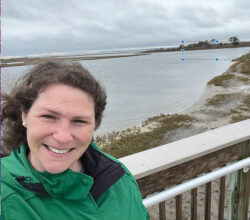
Cathy Janasie, National Sea Grant Law Center Photo courtesy of Cathy Janasie
As senior research counsel, Cathy Janasie provides legal information and analysis to the Sea Grant community, policymakers, and the general public. A New Jersey native, she is based at the National Sea Grant Law Center at the University of Mississippi School of Law, where she has worked for 11 years.
When she talks about the variety of questions she regularly fields, she displays the enthusiasm of a lifelong learner. In any given week, inquiries may range from how to get permits to what’s involved with selling directly to the public without a middleman.
For several years, Janasie has been working on how seaweed will be regulated—“my most fascinating aquaculture project yet.” While the Food and Drug Administration (FDA) has said that seaweed will be treated as a raw agricultural commodity, most growers are small businesses who are exempt from many FDA requirements. So, what are the best practices that ensure the food safety of seaweed? She has created a workshop for state regulators and compiled relevant state laws in pursuit of this question, which is key as seaweed aquaculture grows.
“I think all of us at Sea Grant generally do really important work, especially because we work directly with communities and farmers themselves,” she said. “But the work we do at the Law Center is important because Sea Grant can’t advocate for a position. We’re viewed as a source of non-biased legal research and outreach—information without any kind of spin. I think that’s very valuable.”
New approaches, creative thinking
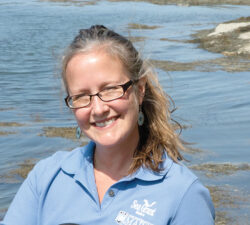
Keri Kaczor, Maine Sea Grant
Photo Kathlyn Tenga-Gonzalez
While maintaining neutrality, Sea Grant seeks to provide information that is rigorous, credible, and, above all, useful—which is the case, according to Maine Aquaculture Association (MAA).
Afton Vigue, MAA’s communications and outreach manager, said that “bringing science to bear for aquaculture producers has been invaluable…We’ve partnered [with Maine Sea Grant] on several key projects including the Aquaculture in Shared Waters training program, which has trained over 400 students in shellfish and seaweed farming over the past 10 years.”
In some cases, that education begins as early as kindergarten.
A Sea Grant veteran since 2003, Keri Kaczor started in a new role last year to build a scientifically literate public and a skilled and ready workforce. One project connects K-12 teachers state-wide with resources and professionals to bring aquaculture education into Maine classrooms. It also introduces sea farmers to nonprofits and education partners to create a stronger understanding of aquaculture and build community acceptability.
“Across the board, I’ve heard that we need to plant the seed of interest much earlier around aquaculture careers, whether it’s research or working on the water,” said Kaczor. Middle school represents an opportunity, she believes, because it’s when career aspirations are forming and parental involvement is still strong—which may also help build social license.
In addition, she is taking aquaculture education beyond coastal communities, which are often already well-resourced. “We have this workforce crisis. Why not try to energize the talent a little further inland?” she asks. As one example, saltwater tanks with aquacultured species have been installed in schools. “When I ask marine scientists how they got hooked, almost everyone says, ‘I had an aquarium as a kid.’”
Building connections
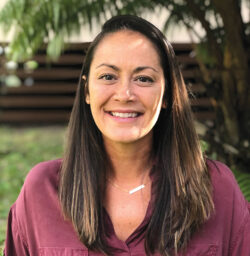
Cherie Kauahi, Hawai‘i Sea Grant
Photo courtesy of Hawai‘i Sea Grant
Cherie Kauahi, a Kanaka Maoli (Native Hawaiian) and aquaculture extension specialist at the University of Hawai’i Sea Grant College Program, is connecting Indigenous and western aquaculture practitioners with a goal to ensure food security.
In recent decades, communities have been reclaiming and restoring loko i‘a (Hawaiian fishponds) constructed by p phaku (stone walls) with mkh (sluice gates) that enclose areas along the coast or inland waterways for raising fish like ‘ama‘ama (mullet) and aholehole (Hawaiian flagtail).
While designed as a food source, this Indigenous practice is also a form of identity that reflects the deep interconnectivity between Hawaiians and the land and ocean.
According to Kauahi, there are many challenges to loko i‘a restoration, including legal policies, water quality, overfishing, historical marginalization, and the continued erasure of Hawaiian practices. But through workshops and other efforts, she is determined to “find ways for groups to work together so that we can see that we are aiming for the same goal.” How can that be done? “By honoring and respecting the Hawaiian perspective,” said says.
Bringing data forward
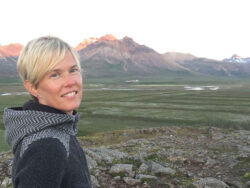
Amy Schrank, Minnesota Sea Grant
Photo courtesy of Amy Schrank
“Collecting the data” is a phrase that echoes throughout a conversation with Amy Schrank, a PhD in zoology and physiology who was appointed extension program lead at Minnesota Sea Grant this year.
Such an emphasis is important as the Great Lakes Region begins to explore new directions. Production there is all land-based (ponds, RAS, and flow-through) and has focused on recreational stocking and bait. “But there is a lot of interest in food fish aquaculture,” said Schrank.
One initiative is an aquaculture market study investigating how consumers feel about farmed fish, what they’re willing to pay, and what species they prefer—“fundamental data,” said Schrank.
Another is comparing performance of recirculating and flow-through systems to produce yellow perch, a “culturally important” species in a region where Friday night fish fries are popular. “One of the really cool things” about this project for Sea Grant, Schrank notes, is the partnership with a yellow perch producer in Minneapolis who has received a grant to build an indoor aquaponics facility for urban food security.
But it’s clear her enthusiasm is always tempered by the data, whether biological, social, or economic. “Aquaculture is hard and really expensive. You hate to see someone start up with no business plan or not knowing about the biology of the organisms they’re trying to raise or water chemistry,” she said.
Community impact
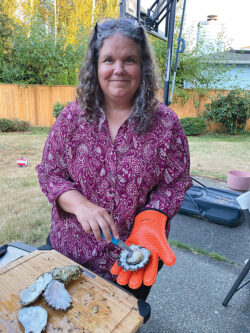
Teri King, Washington Sea Grant
Photo Sean Macduff
“Not many women [were] in fisheries, let alone aquaculture” is how Teri King describes the environment when she was earning her undergraduate and graduate degrees in Fisheries. In 1990, she joined Washington Sea Grant as a water quality specialist, a vital role in the state which is the nation’s largest producer of farmed bivalves.
“Water is life for the organisms being farmed” and clean water is critically important to ensure shellfish is safe to eat, King said. “I quickly learned that failing septic systems were often implicated in water quality degradation.”
What followed were innovations to grab attention and increase involvement with something most people wanted to ignore: a crawl-through septic system at OysterFest (including a toilet at the entrance); Septic Socials; Septic Sense workshops, landscaping contests, and maybe the most engaging bulletins ever written by a biologist. King’s time commitment for follow-up helped ensure the effectiveness of them all.
For work around the Puget Sound, King has earned the highest recognition: imitators in septic education around the US and the world. That’s “very humbling and rewarding,” she said. A favorite of the local press, she received the Community Impact Award from University of Washington College of the Environment in 2015.
Hopes and concerns?
Cathy Janasie speaks for the women of Sea Grant—and the aquaculture industry at large—when she said, “My hopes [for aquaculture] are that it will be a source of food, especially with the growing population and wild fish stocks under stress.
“The concern is that it has minimum impact on the environment and does not interfere with other uses, with fishermen or lobstermen, for example. We just need to make sure it’s done in the right way and everybody will be in a happy place.”
Advertisement
- SAGE receives $350K award to promote gender equality in seafood
- Ocean’s Balance to expand seaweed products with Aqua Veggies





